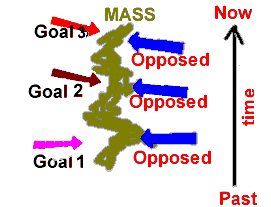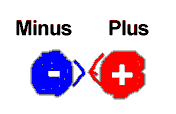|
The |
|
The |
Keywords for Grade 6,
Routine Six End-Words
The subject of GPMs, including materials related to R6-EW, was researched by Ron Hubbard in the 1960s. A full record of this research is part of the Briefing Course and its many taped lectures. It is however not necessary to know every twist and turn of this research if one's purpose is simply to understand how R6-EW is Solo-audited. This keywords glossary should give you adequate data for your practical understanding and application of this Level. A more complete glossary exists for reference.
ALTERNATIVE ROUTE:
If a PC does not go Clear in Dianeticsô auditing he is programmed for the
Alternative Route to Clear. After attesting to having completed the Dianeticsô
auditing the PC is given the Power and Power Plus Grade. Then he does the Solo Auditors Course
and audits R6-EW and the Clearing Course materials to
completion and to the state of Clear.
ROUTINE SIX END-WORDS (R6-EW):
1. Solo-auditing process where the Solo-auditor audits out Locks on the core of
his Reactive Mind. R6-EW is the main process of Grade Six of the Alternative Route
to Clear.
2. In R6-EW the Solo-auditor finds things that he is dramatizing in life and
trace them back to End-words in the Bank and audits this to Key-out. It is a light touch approach to the core of the
Reactive Mind that consists of a number of GPMs (Goal-Problems-Masses).
CC: Stands for Clearing Course. It refers to the materials on that Level and also the auditing action described in those materials leading to the State of Clear.
|
|
|
A problem with two
opposing |
PROBLEM:
1. Anything
that has opposing sides of equal force, especially postulate-counter-postulate,
intention-counter-intention or idea-counter-idea. 2.
It is an intention-counter-intention that worries the Preclear.
GOAL:
A long time effort to reach a certain end result. This end result can be a
beingness, doingness or havingness. Example of a beingness: to become the leader
or top figure of something. Doingness: To become the best (most skillful) chess
player I can be. Havingness: To own a million dollars of property.
Over time the PC has pursued many
different Goals. Some of these major Goals (one at a time) defined the Beings
livingness; his beingness, doingness and havingness. To succeed the Being had to
overcome obstacles and opposition.
Any such Goal will have a long series of Engrams, Overts and Withholds, etc. connected to it. If we have the Goal 'To reach the
North Pole by dog sledge' (just an example) you can imagine the troubles and hardships the person
had to endure to succeed. Injury, freezing, exhaustion, starvation, fighting
polar bears, causing death of other expedition members, etc. They all formed Engrams, Overts, Withholds,
etc.
WHOLE TRACK:
1. The Whole Track is the moment to moment record of a personís existence in
this universe in picture form. Also called the Time-track.
 |
|
A GPM builds up over
many lifetimes. |
GPM ( GOALS PROBLEM MASS ):
1. A GPM is composed of mental masses and
significances which have the same general pattern from person to person. The significances and masses in GPMs dictate certain types of aberrated attitudes and behaviors, pains, sicknesses, feelings of heaviness, tiredness, and other undesirable things. The
significances are usually behind aberrated behavior; the masses, when pulled in
on the individual, are more likely to cause psychosomatic illnesses, pains or feelings of heaviness
and tiredness.
2. A mental energy-mass (or ridge) in the Preclears mind. It came about as a result of a series of long range Goals the Preclear pursued over many lifetimes - one at the time. Each built up mass due to opposition from others and ensuing Engrams, Overts, Withholds, etc. - as explained under 'Goals' above. A Goal is pursued for many, many years and builds up mass. It's what defines the persons beingness, doingness and havingness at the time. The conflict between this Goal and the opposition it faces and continuously has to fight is the basis of the GPM. A new version of that Goal and its opposition adds a new Pair to that GPM. Each Pair is in other words a recorded "eternal conflict". A GPM that comes about this way (as a result of living) is called an Actual GPM.
3. The GPM is a problem created by two or more
opposing ideas. They confront or oppose each other in a balanced way. This
unresolved conflict of ideas or Goals results in a mental mass. A GPM is a
mental energy mass.
4. Ron Hubbard explains the basic mechanism this way: "If you took two fire hoses and
pointed them at each other, their streams would not reach each otherís
nozzles, but would splatter against one another in midair. If this splatter were
to hang there, it would be a ball of messed up water. Call hose A the force the PC
has used to execute his Goal. Call hose B the force other dynamics have used
to oppose that Goal. Where these two forces have perpetually met, a mental mass
is created.
This is the picture of any problem - force opposing force with resultant mass.
Where the PCís Goal meets constant opposition, you have in the Reactive Mind
the resultant mass caused by the two forces: GOAL = force of getting it done,
OPPOSITION = force opposing it getting done. This is the Goal Problem
Mass." (excerpt from taped lecture).
DICHOTOMY:
1. can-can't is the plus and
minus aspect of all thought. It is called a Dichotomy with a specialized word. 2.
a pair of opposites, such as black-white, good-evil,
love-hate.
2. A Dichotomy in relation to GPMs means plus and minus. A plus word and a minus
word.
Each major idea has two parts: a PLUS and a MINUS. These are opposed to each
other.
The two sides are of the same order of things. They always belong to the same overall
group or subject.
Plus and minus form a current between them as you will find in an electrical
battery.
They interchange current. They are in conflict. What is generally agreed to be
the unwanted or poor side is minus. What is generally conceived to be all right
is plus.
Example: we have the major idea that an individual has a financial status.
Wealth is the PLUS and Poverty is the MINUS.
So a DICHOTOMY means two parts of a major idea.
We have two opposites in active conflict with each other.
 |
|
A Dichotomy consists
of |
GPM GOAL:
A Goal in a GPM. It starts with "to" and then it has a verb
(Root-word) and then it has an End-word. A Goal could be: "to catch
cats". "To catch" would be the root, and "cats" the End-word.
END-WORD:
1. An End-word is a noun or a condition made into a noun. It's the final word of a Goal.
2. The End-word is the common denominator to the whole of a GPM.
All the Goals in one GPM have one thing in common: the End-word in these Goals
are one and the same. If the End-word is 'Cats' the Goals could be: 'to breed
cats', 'to catch cats', 'to kill cats', 'to please cats' and so on. The common
denominator is simply the End-word, 'Cats'. So we have a series of Goals related
to the End-word 'Cats' and this End-word is the common denominator that holds
the GPM together in the Bank.
 |
|
A Pair inside the
'Goodness GPM'. |
DRAMATIZATION:
1. To repeat in action what has happened to one in experience. Thatís a basic
definition of it, but much more important, itís a replay now of something that
happened then. Itís being replayed out of its time and period.
2. Complete dramatization is to completely identify past with present. It is the
Engram in full force
in present time with the person taking one or more parts or roles of the dramatic persons
present in the Engram.
3. Thinking or acting in a manner that is dictated by masses or significances
contained in the reactive mind. When dramatizing, the individual is like an
actor playing his dictated part and going through a whole series of irrational
actions.
CHAIN:
1. A series of recordings of similar experiences. A chain has Engrams,
Secondaries and Locks.
2. Incidents of similar nature strung out in time. 3. A series of incidents of
similar nature or subject matter.
© Prometheus International, 2004. Plus fair use quotes from Ron Hubbard's published notes and works.